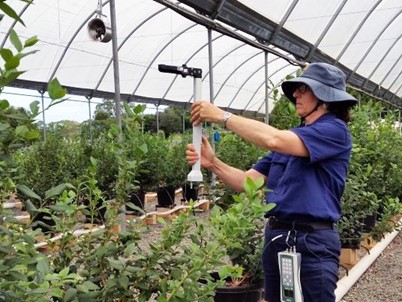
New blueberry water use model in development
20 April 2023
The Clean Coastal Catchments (CCC) Research project is working on a blueberry crop water use model, looking closely at how much water blueberry plants take up under different conditions.

The research is a collaboration between plant physiologist, Dr Michael Forster from Griffith University, and NSW Department of Primary Inudustries Senior Research Scientist, Dr Sophie Parks, from the CCC team.
The water use model will estimate the irrigation needs of blueberry crops as the plants grow and weather conditions change. Once validated, the blueberry water model will be used to develop an interactive irrigation calculator for growers.
“Although blueberries in our experiments currently use 4 to 10 litres of water per day, exactly how much they need in varying production settings will depend on their size, age, growth stage and other seasonal or environmental conditions," explained Dr Parks.
“By measuring sap flow within the plant at different stages of growth and in different weather conditions, we will be able to estimate how much water the crop requires,” she said.
Dr Parks said the water use model will help growers to save water and make more precise decisions about the rates of fertiliser that need to be applied.
“The calculation tool will help growers to irrigate their crops efficiently, and in turn help to reduce potential nutrient runoff, which should lead to better water quality in coastal creeks and rivers.”
The CCC Research project works with growers to keep sediment and nutrients on farms and out of coastal waterways while supporting profitable and sustainable agriculture.
CCC Research is delivered by the NSW Department of Primary Industries and funded through the NSW Marine Estate Management Strategy to improve water quality for our ocean, estuaries, and coastal wetlands.
- This article was originally published on the Marine Estate Management Strategy website.

